Фантастические астрофотографии художников со всего мира, отобранные в шортлист конкурса Insight Astronomy Photographer of the Year 2017 представляет Sputnik.
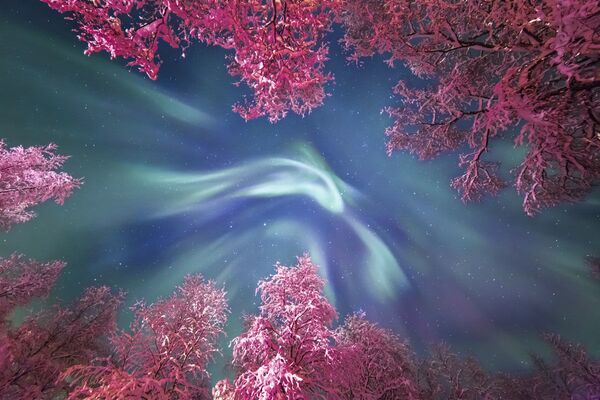
During an astrophotography tour of the Murmansk region with Stas Korotkiy, an amateur astronomer and popularizer of astronomy in Russia, the turquoise of the Aurora Borealis swirls above the snow covered trees. Illuminated by street lamps, the trees glow a vivid pink forming a contrasting frame for Nature’s greatest lightshow.
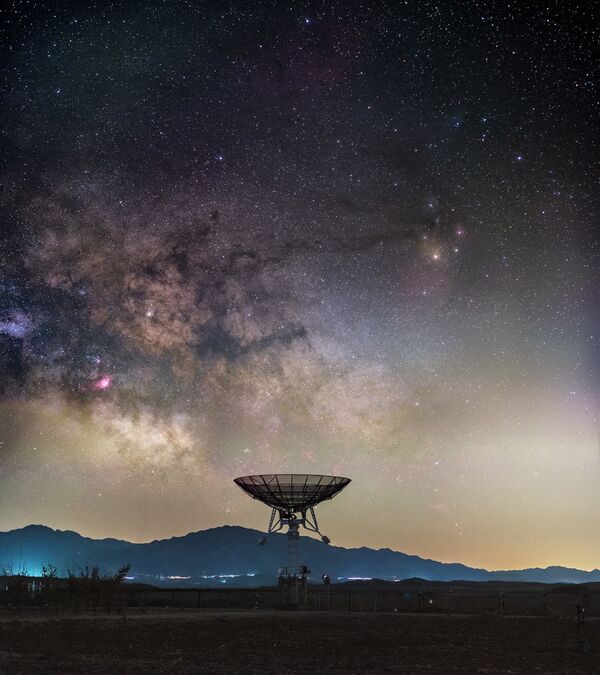
2/25
© Photo : Haitong Yu/Insight Astronomy Photographer of the Year
The Milky Way rises ominously above a small radio telescope from a large array at Miyun Station, National Astronomical Observatory of China, in the suburbs of Beijing. The image depicts the ever-growing light pollution we now experience, which together with electromagnetic noise has turned many optical and radio observatories near cities both blind and deaf – a battle that inspired the photographer’s title of the shot. The image used a light pollution filter (iOptron L-Pro) and multiple frame stacking to get the most of the Milky Way out of the city light.
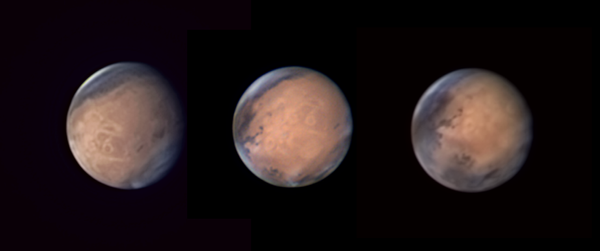
A series photos of Mars taken between 1 June and 3 July 2016 showing Mount Olympus in three different positions. Mount Olympus also known as Olympus Mons is the tallest volcano in the Solar System. The features on the surface of Mars as seen from Earth change rapidly, as seen in the contrast between the central photo, made during the opposition (when Mars is at its closest to the Earth), and the photo on the left, taken 33 days later.

Taken from The Peak, the highest mountain on Hong Kong Island, the image shows the hustle and bustle of the city in contrast to the peaceful starry sky. The haze above the beautiful landscape reminds us that light pollution prevents us from enjoying an even more stunning sky view. Along the coastline the sharp, vibrant light signifies the fast-paced life of cities that many of us have become accustomed to.

A large, searing hedgerow prominence extends from the surface of the Sun on 29 August 2016. There are a number of different prominence types that have been observed emanating from the Sun, and the hedgerow prominence is so called due the grouping of small prominences resembling rough and wild shrubbery.
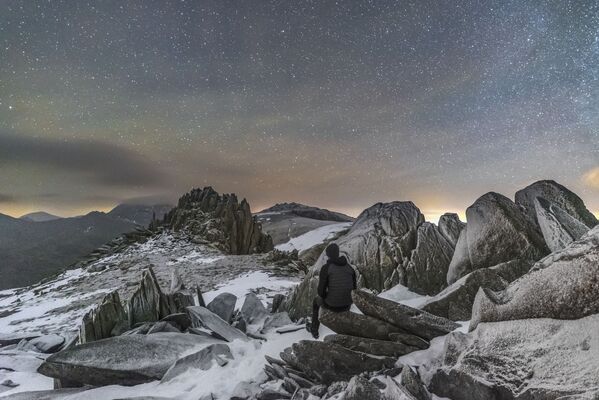
A lone stargazer sits atop the peak of Castell-Y-Gwynt (Castle of the Winds) on Glyder Fach Mountain in Snowdonia, North Wales, beneath a starry night sky during freezing temperatures in mid-winter. The lunar-like landscape was formed through a process called freeze-thaw weathering: water seeps into cracks in the rock, freezing and expanding as ice forms, eventually cracking the rock over hundreds and thousands of years. Despite the full cloud and fog on the night the photographer set up his one-man tent in the snow and began the long wait of 15 hours of darkness in -10°C temperatures but the sky clearing for a mere 20 minutes, was all the time needed to capture this shot.
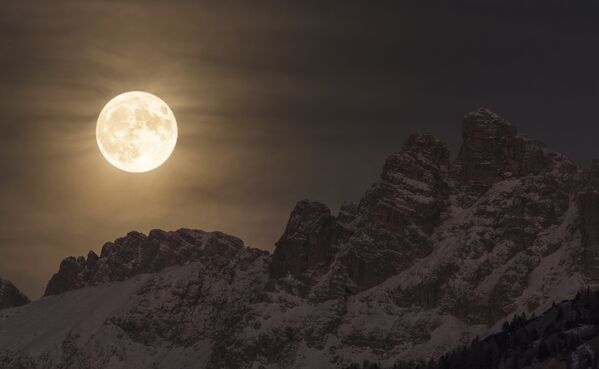
The magnificent sight of the Super Moon illuminating the night sky as it sets behind the Marmarole, in the heart of the Dolomites in Italy. On the night of 14 November 2016, the Moon was at perigee at 356.511 km away from the centre of Earth, the closest occurrence since 1948. It will not be closer again until 2034. On this night, the Moon was 30% brighter and 14% bigger than other full moons.
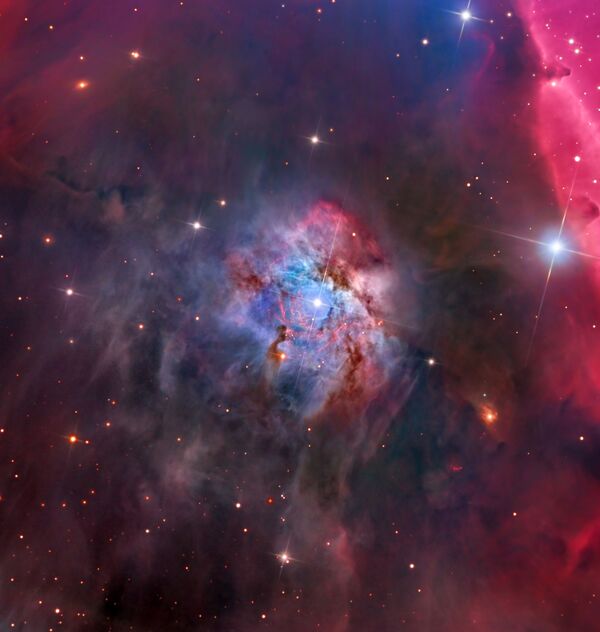
NGC 7331 is an unbarred spiral galaxy found some 40 million light years away from Earth, in the constellation Pegasus. Of the group of galaxies known as the Deer Lick Group, NGC 7331 is the largest, and can be seen dominating the image whilst the smaller galaxies NGC 7335, NGC 7336, NGC 7337, NGC 7338 and NGC 7340 drift above it.
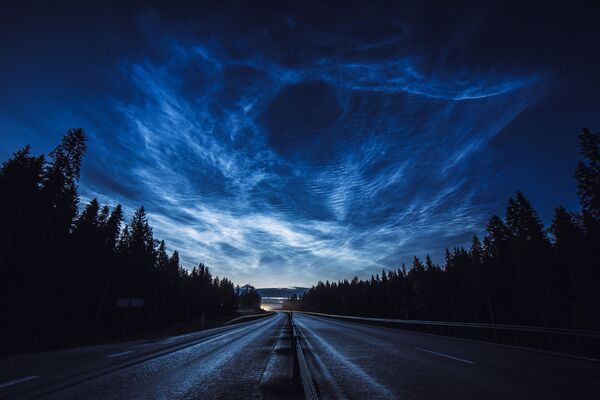
Noctilucent clouds stretch across the Swedish sky illuminating a motorcyclist’s ride home in this dramatic display. Noctilucent clouds are the highest clouds in the Earth’s atmosphere and form above 200,000 ft. Thought to be formed of ice crystals, the clouds occasionally become visible at twilight when the Sun is below the horizon and illuminates them.

The Sun photographed in Calcium-K light, depicting the star’s inner chromosphere. In the colour-rendering scheme used, the surface is shown as negative, with the sunspots as bright spots, but the area outside the limb is shown with increased contrast, highlighting a surge on the western limb, and several small prominences. Although the Sun is shown entering a quieter phase, a lot of activity is still taking place, illustrating just how dynamic our star is.
Groningen, Netherlands, 4 April 2017
Groningen, Netherlands, 4 April 2017
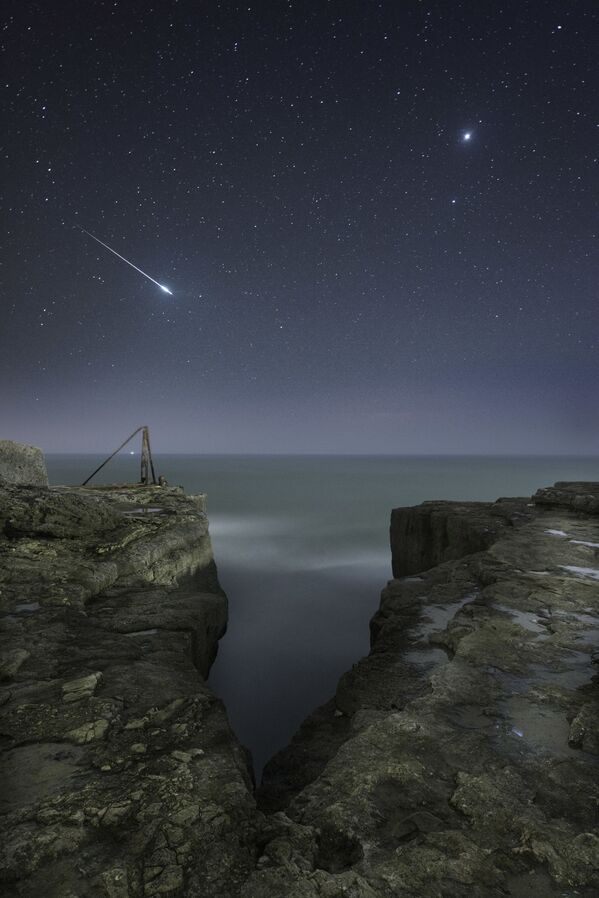
A shooting star flashes across the sky over the craggy landscape of Portland, Dorset, as our neighbouring planet Venus looks on. The image is of two stacked exposures: one for the sky and one for the rocks.
Portland, Dorset, UK, 25 March 2017
Portland, Dorset, UK, 25 March 2017
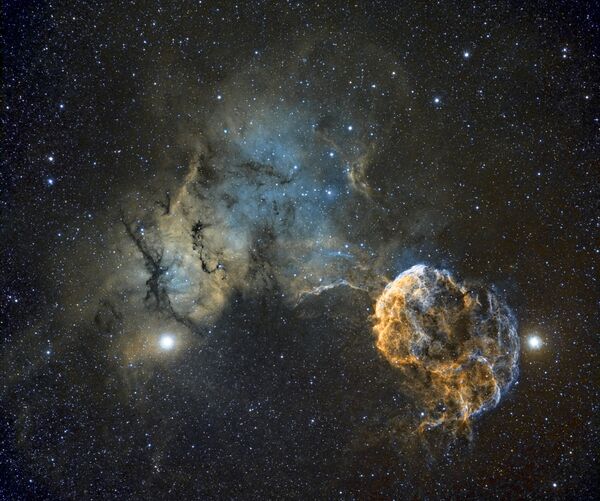
Lying in the constellation of Gemini, IC443 is a galactic supernova remnant, a star that could have exploded as many as 30,000 years ago. Its globular appearance has earned the celestial structure the moniker of the Jellyfish Nebula. Pictured to the upper left of the Jellyfish Nebula is a much fainter background area of nebulosity, which is actually a large cloud of mostly molecular hydrogen gas and dust.. ‘The Jellyfish’ is a convoluted tangle of gaseous filaments rapidly expanding away from the initial explosion. Professional observatory data shows that what we are actually seeing are two lobes superimposed on each other, but from this angle one appears as the head of the jellyfish (to the left) and the other lobe (to the right) as the dangling tentacles. It is illuminated by a few young blue embedded stars and criss-crossed by tendrils of dark dust clouds lying between us and the bright nebula.
Macclesfield, Cheshire, UK, 29 November 2016
Macclesfield, Cheshire, UK, 29 November 2016
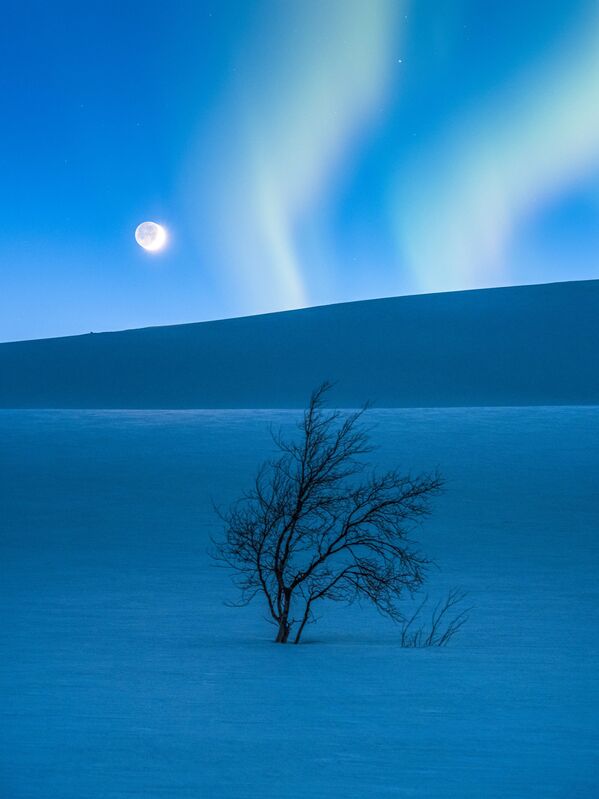
The setting crescent Moon and Mars gaze over Saltfjellet, Norway as the Northern Lights appear to emanate from the snowy landsape. The Aurora Borealis were an unexpected guest in the shot as the Sun was only about ten degrees under the horizon meaning the early display came as a surprise.
Saltfjellet, Nordland, Norway, 30 March 2017
Saltfjellet, Nordland, Norway, 30 March 2017
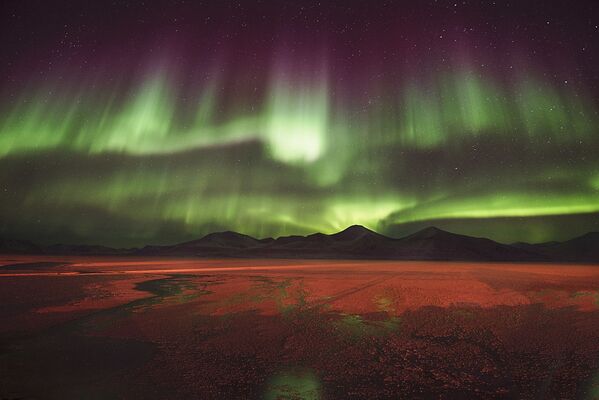
The purples and greens of the Northern Lights radiate over the coal mining city of Svea, in the archipelago of Svalbard. The earthy landscape below the glittering sky is illuminated by the strong lights of industry at the pier of Svea.
Svea, Svalbard, Norway, 25 February 2017
Svea, Svalbard, Norway, 25 February 2017
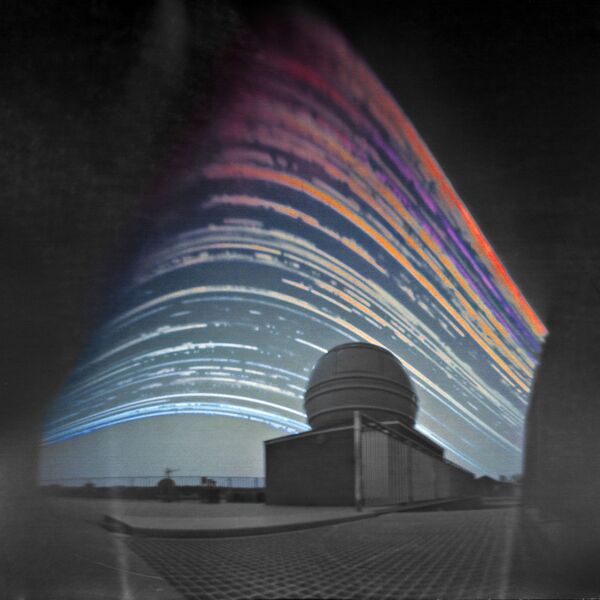
Taken with a solargraphy pinhole camera, the image charts the movement of the Sun over the Astronomical Institute of the Czech Academy of Sciences, Prague with an exposure of half a year (21 December 2015–21 June 2016). As a photosensitive material, regular black-and-white photographic paper without developing was used, and after exposure the negative was scanned and post-processed using a graphic program (colour and contrast enhancement). The exposure time was from solstice to solstice, thus recording the solar trails above the telescope dome and the rainbow of colours of the trails are the result of the sensitivity of the paper changing as it is exposed to different temperatures and humidity.
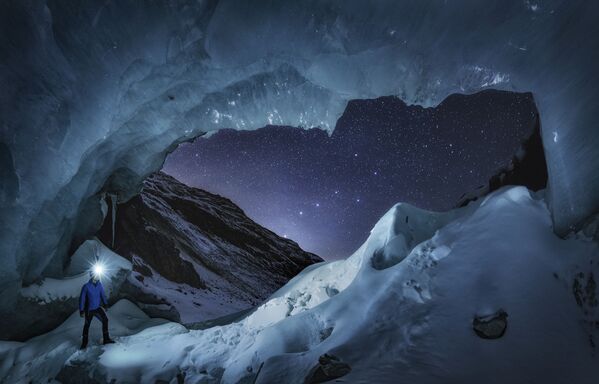
A stargazer observes the constellation of the Big Dipper perfectly aligned with the window of the entrance to a large glacier cave in Engadin, Switzerland. This is a panorama of two pictures, and each is a stack of another two pictures: one for the stars and another one for the foreground, but with no composing or time blending.
Engadin, Graubünden, Switzerland, 29 December 2016
Engadin, Graubünden, Switzerland, 29 December 2016
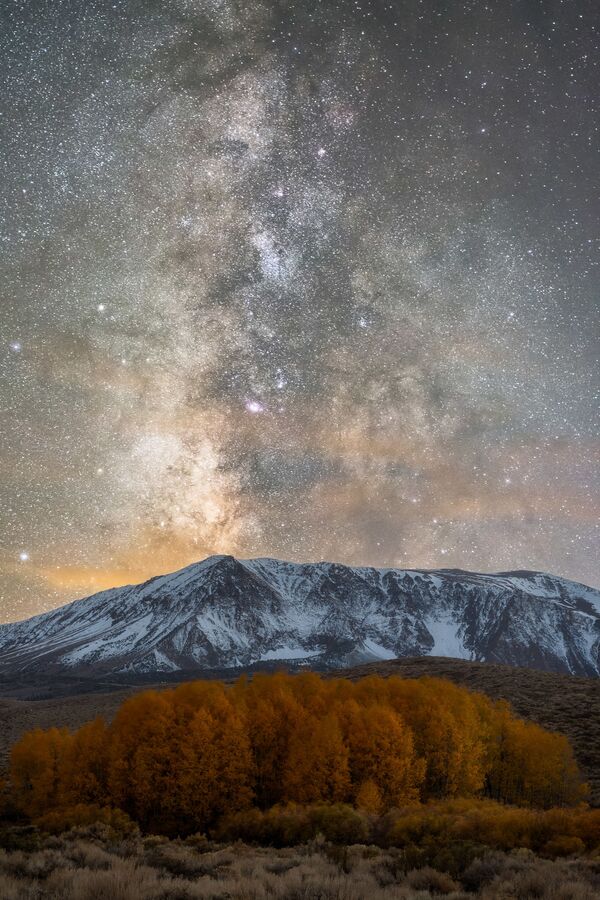
The snow-clad mountain in the Eastern Sierras towers over the rusty aspen grove aligned perfectly in front of it, whilst our galaxy the Milky Way glistens above.
Eastern Sierras, California, USA, 21 October 2016
Eastern Sierras, California, USA, 21 October 2016
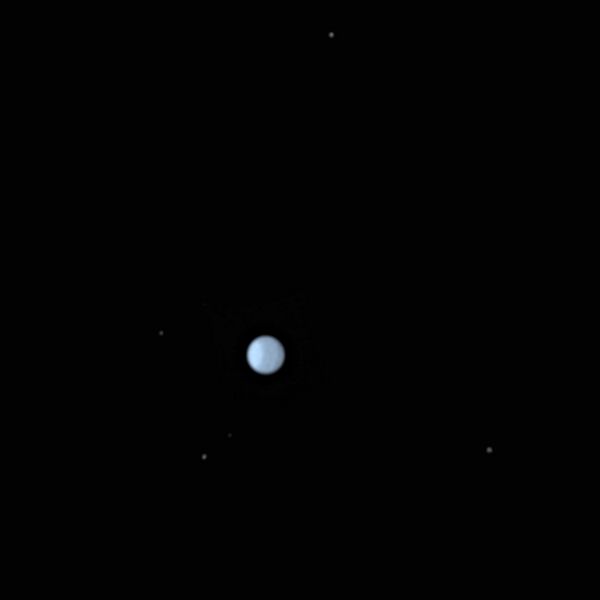
The distant ice giant Uranus, the seventh furthest planet from the Sun, some 2.6 billion kilometres (at its closest) away from our own planet is entered into the competition for the first time. Found in the constellation of Pisces, here it can be seen surrounded by its five brightest moons: Ariel, Miranda, Umbriel, Titania and Oberon. Taken on an exceptionally still night in late December, an infrared filter was used to further improve the viewing and to bring out the planet's belt and cloud details. As the planet lies so far away and appears so dim to us on Earth, Uranus seems to be tiny at 3.7 inches across.
St. Albans, Hertfordshire, UK, 29 December 2016
St. Albans, Hertfordshire, UK, 29 December 2016
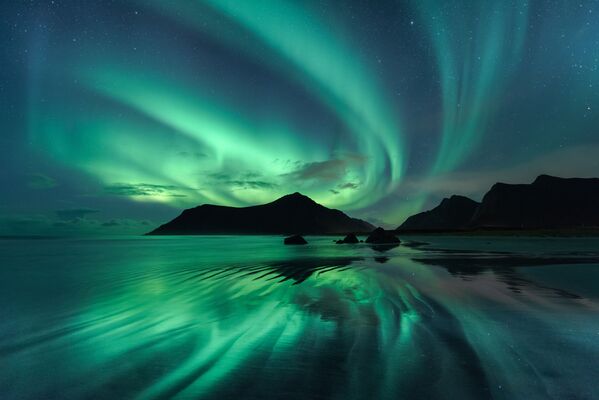
The reflection in the wave ripples of Skagsanden beach mirrors the brilliant green whirls of the Aurora Borealis in the night sky overhead. To obtain the effect of the shiny surface, the photographer had to stand in the wave zone of the incoming flood, and only when the water receded very low did the opportunity to capture the beautiful scene occur. Skagsanden, Lofoten, Norway, 28 October 2016.
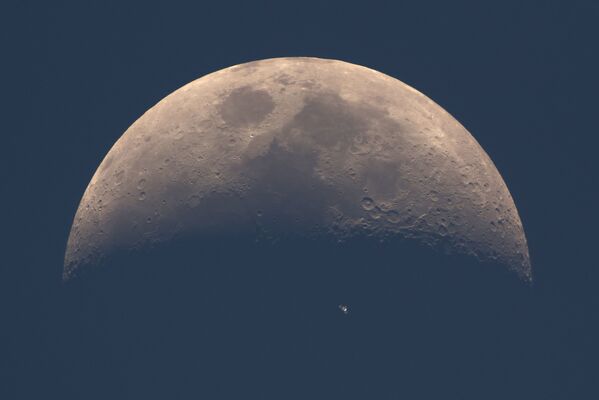
The International Space Station (ISS) whizzes across the dusky face of the Earth’s natural satellite, the Moon, whilst photographed in broad daylight. Shining with a magnitude of -3.5, the ISS was illuminated by the Sun at a height of 9º on the horizon. Like the Moon, the ISS receives solar rays in a similar way during its 15 orbits of the Earth a day, making it possible to see it when the Sun is still up. This is a real shot, with no composite or clipping in the process. Madrid, Spain, 2 April 2017.

The radiant, concentric star trails seemingly spinning over a lone stargazer against the glowing purples and pinks of the night sky during the hour when the clocks ‘spring forward’ to begin British Summer Time. With time so intrinsically linked to celestial activity, a one-hour star trail seemed the perfect metaphor. Through the use of long exposures, the trails depict the rotation of the Earth on its axis centring on the north celestial pole, the sky moving anti-clockwise around this point. Titchfield, Hampshire, UK, 26th March 2017.

On 31 October 2016, Near Earth Asteroid 164121 (2003 YT1) made a close encounter with Earth at 3 million miles. This Apollo asteroid with an orbital period of 427 days was discovered by the Catalina Sky Survey on 18 December 2003. The photographer’s first attempt at imaging the asteroid was done with a camera on a fixed tripod, controlled by Astrophotography Tool software. The asteroid moved so fast I could see it moving on the live screen. The negative image is a stack of 56 cropped images created using PIPP and Deep Sky Stacker software and was processed with IrfanView and Photoshop for scientific content rather than cosmetic appearance. Loughborough, Leicestershire, UK, 2 November 2016.
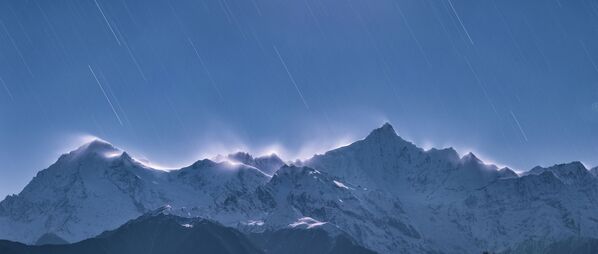
The stars beam down on to the Meili Snow Mountains, also known as the Prince Snow Mountains - the highest peaks in the Yunnan Province, China. It is world-renowned for its beauty and is one of the most sacred mountains in Tibetan Buddhism. The moonlight striking the top of the mountains appears to give them an ethereal quality. DeQin, Yunnan Province, China, 16 January 2017.
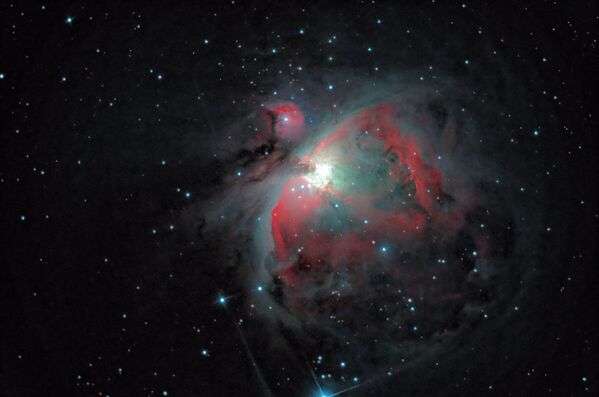
Lying 1,300 light years away from Earth, the Orion Nebula is found in Orion’s Sword in the famous constellation named after the blade’s owner. The Orion Nebula is one of the most photographed and studied objects in the night sky due to the intense activity within the stellar nursery that sees thousands of new stars being created, which also makes it a relatively easy target for beginners. The nebula is thought to measure about 24 light years across and have a mass 2000 times that of our Sun. London, UK, 15 February 2017.
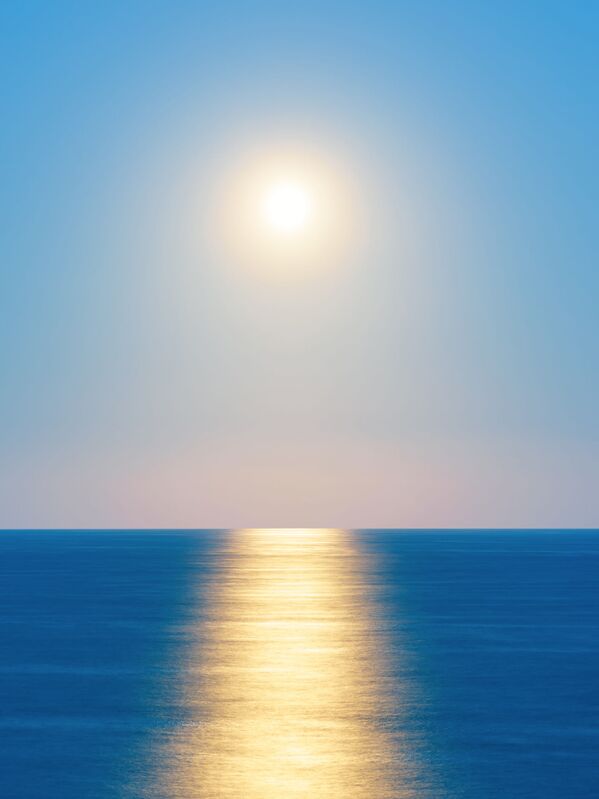
An unexpected shot of the Moon rising over the glistening ocean off the Wairarapa coast, bearing a remarkable resemblance to the Sun. As the photographer was capturing the sunset over Castlepoint, he looked over his shoulder to see the Moon rising behind, reflecting off the wide expanse of the Pacific Ocean, and it became the new subject of his image. Wellington, New Zealand, 11 February 2017.

